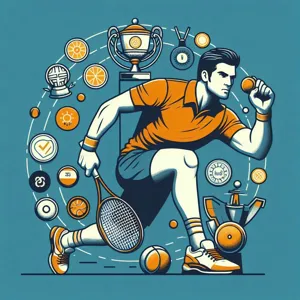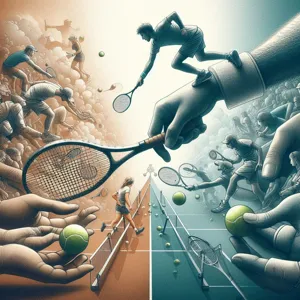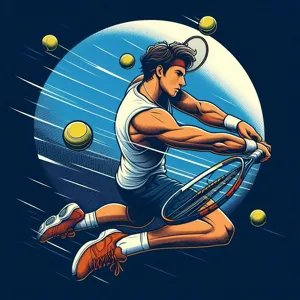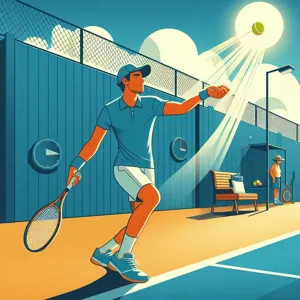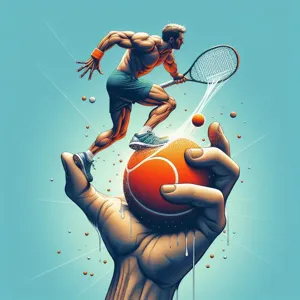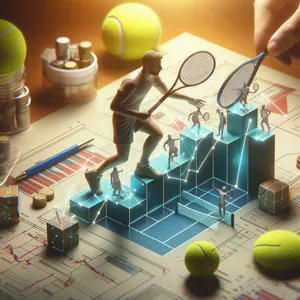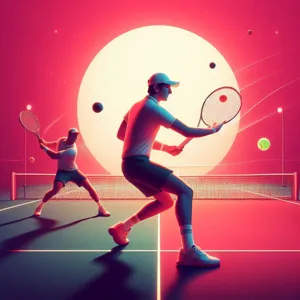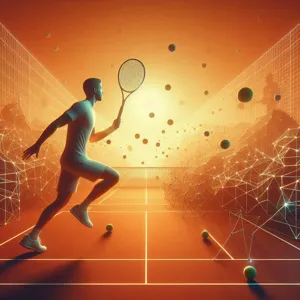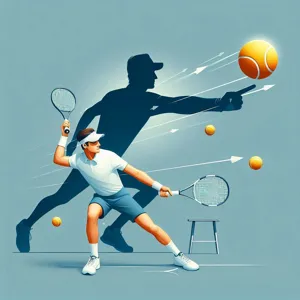Tennis, a game defined by precision, strategy, and agility, offers players the thrilling challenge of mastering both their physical and mental skills on the court.
Whether you’re a budding enthusiast eager to improve your performance or a seasoned player looking to elevate your game to the next level, understanding the nuances of the sport is essential. In this blog post, we’ll delve into practical strategies that can help you see the court more clearly, enhance your decision-making, and fine-tune your technique. From honing your footwork and developing your serve to mastering the art of anticipating your opponent’s moves, these proven tips will empower you to play with confidence and finesse. Join us as we explore the key elements that can transform your game, ensuring you approach each match with clarity and determination.
1. Understanding the Basics of Court Positioning

Court positioning is the foundation upon which your entire tennis game is built. It’s not just about where you stand when the ball is in play; it’s about anticipating your opponent’s moves, responding to their shots, and placing yourself in the optimal position to make your next move. A solid understanding of court positioning can elevate your game from casual rallies to competitive matches.
At the heart of effective court positioning is the concept of balance and readiness. When you position yourself correctly on the court, you can react swiftly to your opponent’s shots, whether they’re playing a powerful forehand or a delicate drop shot. This means keeping your feet shoulder-width apart, maintaining a slight bend in your knees, and being on the balls of your feet. This athletic stance not only enhances your mobility but also allows you to shift your weight seamlessly in any direction.
Moreover, your position should adapt based on the situation. For instance, when your opponent is serving, it’s essential to stand at a comfortable distance behind the baseline, ready to return the ball with force. Conversely, when you’re at the net, your positioning will need to be more aggressive to intercept volleys and put pressure on your opponent.
Understanding the geometry of the court also plays a crucial role. Visualize the court as a grid, breaking it down into zones that dictate how to move and respond. By mastering the concept of “inside the baseline” and “behind the baseline,” you’ll learn when to attack and when to defend, ultimately enhancing your strategic approach to the game.
Practice makes perfect. Dedicate time to drills that focus on court coverage, positioning, and footwork. Incorporate shadow swings where you visualize your opponent’s shots while practicing your movement on the court. The more familiar you become with these principles, the more instinctive your positioning will be during matches.
In essence, mastering court positioning not only improves your own game but also helps you read your opponent’s play. By understanding and implementing these basics, you’ll find yourself confidently moving on the court, ready to seize every opportunity and elevate your tennis performance to new heights.
2. The Importance of Footwork in Tennis
When it comes to tennis, the adage “the game is played on your feet” couldn’t be more accurate. Footwork is the foundation upon which every successful shot is built, influencing your ability to reach the ball, maintain balance, and execute precise strokes. Imagine standing on the court, the sun shining, the crowd murmuring in anticipation; the moment the ball is served, your footwork determines whether you’ll be poised for a brilliant return or scrambling to keep the rally alive.
Good footwork allows you to position yourself optimally for each shot, reducing the risk of injury while maximizing your reach. Quick, agile movements enable players to respond to their opponent’s shots with ease, whether you’re darting to the net to volley or retreating to the baseline for a powerful groundstroke. The quicker and more efficiently you can move, the more time you have to set up your shot, leading to improved accuracy and power.
To enhance your footwork, incorporate drills that focus on agility and speed. Ladder drills, cone sprints, and shadow swings can help develop the quickness and precision needed on the court. Additionally, practicing lateral movement and incorporating split-step techniques into your game will allow you to engage in rallies with greater confidence and effectiveness. Remember, every step you take should be intentional; proper footwork not only helps you to chase down balls but also positions you to strike with authority.
In the heat of a match, where every point counts, solid footwork can be the difference between victory and defeat. By prioritizing this essential skill, you’ll find that your overall game elevates, allowing you to dictate play and outmaneuver your opponents. So lace up those sneakers and hit the court—your feet are your greatest asset in the quest for tennis excellence.
3. Analyzing Opponent’s Patterns: Reading the Game

Understanding your opponent’s patterns is one of the most effective strategies to elevate your tennis game. Tennis is as much a mental battle as it is a physical one, and being able to read your opponent’s tendencies can give you a significant edge on the court. Start by observing how they serve—do they favor a particular side? Do they follow up their serve with a predictable shot? Noticing these nuances early in the match can allow you to anticipate their moves and position yourself accordingly.
As the game progresses, pay attention to their shot selection during rallies. Are they more comfortable hitting forehands from the baseline, or do they shy away from backhand exchanges? Are they quick to approach the net after a deep shot, or do they prefer to stay back? By identifying these patterns, you can craft your strategy to exploit their weaknesses. For instance, if your opponent consistently struggles with high balls to their backhand, aim to elevate your shots to keep them off balance.
Equally important is adjusting your tactics in response to their adaptations. A savvy opponent will often change their approach mid-match, so remain vigilant and flexible. Incorporate elements of unpredictability into your game as well—vary your shots and placements to keep them guessing. This constant dance of reading and responding not only sharpens your skills but also heightens the competitive thrill of each match.
Remember, analyzing your opponent’s patterns isn’t just about winning points; it’s about gaining confidence and control over the game. The more you practice this skill, the clearer the court will become, and soon you’ll be orchestrating the flow of the match to your advantage. Elevate your game by transforming yourself into a keen observer—every match is a new opportunity to refine this essential strategy.
4. Mastering the Art of Shot Selection
Mastering the art of shot selection is a game-changer for any tennis player striving to elevate their performance on the court. Understanding when to play aggressively and when to adopt a more defensive strategy can make all the difference in a match.
The first step in honing your shot selection is to develop a keen awareness of both your strengths and weaknesses as well as those of your opponent. Are you more comfortable with forehand winners, or do you excel at precise backhand slices? Take stock of your favorite shots and practice them until they become second nature. At the same time, observe your opponent’s tendencies. If they struggle with high balls, for example, aim for deep, lofty shots that exploit that weakness.
Another crucial aspect is the ability to read the game as it unfolds. Tennis is as much about mental acuity as it is about physical skill. Pay attention to the flow of the match — if your opponent is consistently hitting to your weaker side, consider redirecting the play to keep them guessing. This strategic unpredictability can create openings for you to seize control of the point.
Additionally, embrace the concept of shot variety. Relying on a single type of shot can quickly become predictable, making it easier for your opponent to anticipate your moves. Incorporate a mix of topspin, slices, and drop shots into your arsenal to keep your adversary off-balance. By introducing unexpected elements to your game, you can dictate the pace and rhythm of the match, forcing your opponent to adapt to your style rather than the other way around.
Lastly, practice makes perfect. Regularly simulate match situations during training sessions, focusing on decision-making under pressure. Use drills that challenge you to choose the right shot in various scenarios, honing your instincts and building confidence in your selections. The more you expose yourself to real-game situations, the sharper your shot selection will become.
By mastering the art of shot selection, you’ll not only enhance your tactical approach but also elevate your overall game, ensuring that you remain a formidable presence on the court.
5. Developing a Strategic Serve: Placement and Power
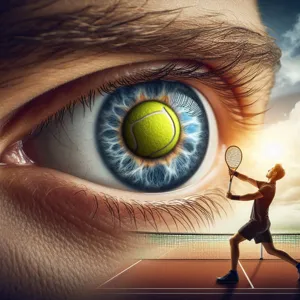
When it comes to tennis, the serve is not just a way to start the point; it’s an opportunity to seize control of the match right from the first strike. Developing a strategic serve involves a delicate balance of placement and power, and mastering this can significantly elevate your game.
**Placement** is the key to outsmarting your opponent. Instead of simply blasting the ball as hard as you can, focus on directing your serve to specific areas of the service box. Aim for the corners, keeping your opponent guessing and forcing them to move. A well-placed serve can lead to weak returns, giving you the upper hand as you prepare for the next shot. Experiment with different types of serves—like the slice and the kick serve—to keep your opponent off-balance. Each serve should have a purpose, whether it’s to pull your opponent wide off the court or jam them at the body.
**Power**, while important, should not overshadow the importance of precision. A powerful serve can be impressive, but if it lands out or gives your opponent an easy return, it’s of little use. Work on your technique to harness that power effectively. Engage your legs, core, and shoulder to generate maximum force while maintaining control. The goal is to hit with enough speed to challenge your opponent but also ensure accuracy in your placement.
Incorporating these elements into your practice routine can significantly enhance your serving strategy. Use drills that emphasize both placement and power, and consider recording your serves to analyze your technique. The more you refine your serve, the more confident you’ll feel when it’s time to step up to the line during a match. Remember, a strategic serve can set the tone of the game, allowing you to dictate play from the very first point. So, focus on developing a serve that not only packs a punch but also keeps your opponents on their toes.
6. Utilizing Angles to Control the Court
Mastering the angles on the tennis court can be a game-changer for your performance. When you learn to manipulate angles effectively, you not only gain a strategic edge over your opponent but also create opportunities to dictate the pace and flow of the match.
Imagine standing at the baseline, your opponent poised to respond to your next move. By hitting the ball at sharp angles—whether with a forehand or backhand—you can force them to stretch and reposition themselves, often putting them at a disadvantage. This technique can lead to openings that allow you to either set up for an easy volley at the net or create space for a powerful cross-court shot.
To master this skill, practice hitting the ball with a focus on placement rather than just power. Visualize the court as a grid and aim for the corners or sidelines, making the most of the court’s dimensions. During drills, work with a partner to develop your ability to hit angled shots consistently, ensuring that you can execute this strategy under pressure during a match.
Additionally, understanding your opponent’s weaknesses can help you exploit angles more effectively. If you notice they struggle with wide shots, aim to draw them out of position. Conversely, if they excel at defending against angles, be prepared to adapt and play more towards their strengths.
Incorporating angle play into your strategy not only enhances your control over the court but also keeps your opponent on their toes, making every rally an opportunity to take the upper hand. As you refine this aspect of your game, you’ll find that your overall performance improves, allowing you to see the court not just as a playing field, but as a canvas for your tactical artistry.
7. The Role of Mental Toughness in Competitive Play
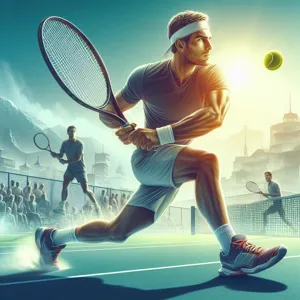
In the high-stakes world of competitive tennis, mental toughness can be the defining factor between victory and defeat. While physical skills, such as powerful serves and agile footwork, are crucial, the psychological aspect of the game often plays an even more significant role. As players step onto the court, they are not just battling their opponents but also grappling with their own thoughts, emotions, and self-doubt. Developing mental resilience is essential for maintaining focus, composure, and confidence, especially during critical moments in a match.
Imagine being in the middle of a tense fifth set, the score tied, and your opponent is serving at match point. It’s in these moments that mental toughness shines. Players who can harness their inner strength are better equipped to stay calm under pressure, allowing them to execute their game plan and make strategic decisions rather than succumbing to anxiety. Techniques such as visualization, positive self-talk, and mindfulness can help athletes cultivate a robust mental framework. By visualizing successful plays, reminding themselves of their strengths, and staying present in the moment, players can fend off negative spirals and keep their focus sharp.
Moreover, mental toughness extends beyond the court. It involves developing a growth mindset—viewing challenges as opportunities for improvement rather than insurmountable obstacles. Embracing this mindset allows players to learn from losses, adapt their strategies, and approach each match with renewed determination. Whether you’re a seasoned competitor or just starting out, investing time in enhancing your mental game is crucial. In the demanding arena of tennis, where every point counts, the ability to stay mentally strong can elevate your performance and ultimately lead you to success. Remember, it’s not just about playing the game; it’s about mastering the mind that plays it.
8. Practicing Effective Communication with Your Doubles Partner
Effective communication with your doubles partner can be the secret ingredient that transforms a good team into a great one. Unlike singles, where the focus is solely on individual performance, doubles tennis thrives on synergy and collaboration. Establishing clear lines of communication allows you and your partner to anticipate each other’s movements, strategize on the fly, and respond cohesively to the dynamics of the match.
Start with the basics: verbal cues. Simple phrases like “Mine!” or “Yours!” can help avoid confusion on who should take the shot, especially during fast-paced rallies. It’s not just about shouting commands; it’s about fostering trust and understanding. Make it a habit to discuss your preferred shots and positions on the court before the match begins. This way, you can align your strategies and minimize overlaps during gameplay.
Non-verbal communication is equally crucial. Quick glances, hand signals, or even a nod can convey intention without interrupting the flow of the game. For instance, a subtle point towards the net can indicate that you’re planning to volley, while a simple gesture can signal when to switch up your formation. During the match, take the time to check in with each other, especially after pivotal points. Positive reinforcement can boost morale and create a supportive atmosphere that enhances performance.
Lastly, don’t forget the importance of post-match communication. Whether you win or lose, discussing what worked and what didn’t can provide valuable insights for future matches. Celebrate your successes, analyze your mistakes, and most importantly, keep the conversation constructive. By practicing effective communication, you’ll not only elevate your own game but also create a stronger, more cohesive partnership on the court. This collaborative spirit is what makes doubles tennis not just a sport, but a shared journey toward improvement and success.
9. Implementing Drills to Improve Court Awareness
Implementing drills to improve court awareness is a game-changer for any tennis player looking to elevate their performance. Court awareness refers to your ability to read the game, anticipate your opponent’s moves, and position yourself optimally for each shot. By incorporating targeted drills into your practice routine, you can sharpen these skills and gain a competitive edge on the court.
One effective drill is the “Shadow Swing” exercise. This involves practicing your strokes without the ball while visualizing your opponent’s position and the court layout. As you perform your swings, focus on where your imaginary opponent would be standing and how you would respond to their shots. This exercise not only hones your stroke mechanics but also reinforces spatial awareness, helping you develop a mental map of the court.
Another excellent drill is the “Four Corners” drill. Set up cones or markers in each corner of the court and move between them, hitting forehands and backhands as you go. This drill forces you to be mindful of your positioning and encourages quick footwork, allowing you to become more comfortable with the dimensions of the court. As you improve your movement and positioning, you’ll find it easier to handle various game situations.
Additionally, consider partnering with a fellow player for a “Cross-Court Rally” drill. This exercise involves hitting the ball back and forth while only targeting the cross-court area. This not only helps you practice your shot placement but also encourages you to keep your eyes on your opponent’s position, enhancing your overall awareness of the court dynamics.
Finally, don’t underestimate the power of video analysis. Recording your matches or practice sessions can provide valuable insights into your court awareness. Review the footage to identify areas for improvement—are you staying too close to the baseline? Are you anticipating your opponent’s shots effectively? By watching yourself in action, you can pinpoint specific adjustments to make in your gameplay.
Incorporating these drills into your training regimen will significantly enhance your court awareness, allowing you to respond more effectively during matches and ultimately elevate your overall tennis game. The more aware you are of your surroundings, the better equipped you’ll be to capitalize on opportunities and outmaneuver your opponents.
10. Adapting Your Strategy to Different Court Surfaces
When it comes to tennis, the court surface can significantly influence your playing style, strategy, and overall performance. Each surface—be it grass, clay, or hard court—has its unique characteristics that can either enhance or hinder your game. Understanding these nuances and adapting your strategy accordingly is key to elevating your tennis skills.
**Grass Courts:** Fast and often unpredictable, grass courts reward players who excel in quick reflexes and serve-and-volley tactics. The ball skids and bounces low, making it essential to stay aggressive at the net. To adapt, focus on developing a powerful serve and sharpen your volleying skills. Practice quick footwork to position yourself for those rapid exchanges, and consider using slice shots to take advantage of the surface’s speed.
**Clay Courts:** On the other end of the spectrum, clay courts are slower, allowing for longer rallies and more strategic play. The high bounce gives players more time to react, making it crucial to incorporate patience and consistency into your game. Adapt your strategy by emphasizing baseline rallies and constructing points carefully. Work on your topspin shots, which are particularly effective on clay, and practice sliding into your shots to maintain balance and control on this softer surface.
**Hard Courts:** Hard courts offer a balanced blend of both grass and clay, providing a moderate pace that can vary depending on the specific court type. Here, versatility is vital. Players should be able to transition seamlessly between aggressive play and defensive tactics. To adapt, focus on developing a well-rounded game that includes a mix of powerful serves, groundstrokes, and net play. The ability to read your opponent’s game and adjust your strategy mid-match can make all the difference on this versatile surface.
Incorporating these adjustments into your training regimen will not only help you perform better on different surfaces but also build your confidence as a player. Remember, the key to mastering tennis is not just about honing your skills but also about understanding the environment in which you play. By adapting your strategy to suit the court surface, you’ll find yourself elevating your game and enjoying the sport even more.
11. Learning from the Pros: Analyzing Matches
One of the most effective strategies for elevating your tennis game is to learn from the professionals by analyzing their matches. Elite players possess a wealth of knowledge and skills that can significantly enhance your understanding of the game and your own performance on the court.
Start by selecting a few of your favorite professional matches—whether it’s a Grand Slam final or an intense rivalry showdown. As you watch, pay close attention to various elements: the players’ footwork, shot selection, and strategic positioning. Notice how they construct points, transitioning from defense to offense with seamless fluidity. Analyzing these aspects will not only inspire you but also provide a tactical framework you can adapt to your own game.
Consider taking notes during the match. Jot down specific strategies that resonate with you—perhaps how a player uses angles to pull their opponent off the court or how they anticipate shots and move accordingly. Look for patterns in their play, like how they respond to different types of serves or how they handle high-pressure situations. This detailed observation can help you identify strengths to build upon and weaknesses to work on in your own play.
Additionally, many professional matches are accompanied by commentary that highlights key strategies and psychological elements at play. Listen for insights from former pros and coaches, as they often provide valuable context and analysis that can deepen your understanding of the game.
After your viewing session, take the time to implement what you’ve learned in your practice sessions. Whether it’s mimicking a pro’s serving technique or employing a particular strategy during a match, applying these lessons can create a tangible impact on your game. Watching and analyzing matches not only fuels your passion for tennis but also equips you with the tools needed to elevate your own performance on the court. Embrace this strategy, and you may find that your game evolves in ways you never imagined.
12. The Impact of Physical Conditioning on Performance
When it comes to elevating your tennis game, the importance of physical conditioning cannot be overstated. Tennis is a demanding sport that requires not only skill and strategy but also peak physical fitness. Good conditioning enhances your strength, speed, endurance, and agility—all critical components that can dictate the outcome of a match.
To begin with, focusing on your cardiovascular fitness is essential. Tennis matches can be long and grueling, often stretching over several hours. A well-conditioned cardiovascular system allows you to maintain high energy levels throughout the match, enabling you to chase down balls and sustain rallies without succumbing to fatigue. Incorporating activities such as running, swimming, or cycling into your training regimen can significantly improve your stamina on the court.
Strength training is another crucial aspect of physical conditioning for tennis players. Strong muscles contribute to powerful serves and groundstrokes, as well as stability during quick lateral movements. Exercises targeting the core, legs, and arms—such as squats, lunges, and resistance training—can help you build a solid foundation for explosive movements and injury prevention.
Agility and flexibility are equally vital. Tennis requires rapid changes in direction, so agility drills, such as ladder exercises and cone drills, can enhance your footwork and reaction time. Flexibility training, including dynamic stretches and yoga, not only improves your range of motion but also aids in recovery, reducing the risk of injuries that can sideline your progress.
Lastly, the mental aspect of conditioning should not be overlooked. Developing mental resilience through conditioning can help you stay focused and composed during high-pressure moments in a match. Incorporate mindfulness practices or visualization techniques into your training to boost your mental stamina.
In summary, prioritizing physical conditioning is a game-changer for any tennis player looking to elevate their performance. By improving your cardiovascular fitness, strength, agility, and mental resilience, you’ll be better equipped to handle the rigors of the court, allowing your skills and strategy to shine through when it matters most.
13. Building a Strong Pre-Match Routine
A strong pre-match routine can be the cornerstone of not just your performance on the court, but also your mental resilience and overall confidence. Just as a musician practices scales before a concert, or an athlete warms up before a big game, establishing a consistent ritual can set the tone for your match and help you enter the competition with clarity and focus.
Start by identifying the elements that work best for you, which might include a mix of physical warm-ups, mental exercises, and even a healthy snack to fuel your body. Engage in dynamic stretches to loosen your muscles and prepare your body for the quick movements and explosive power required in tennis. Consider incorporating agility drills that mimic the lateral movements you’ll utilize during play; this not only sharpens your physical readiness but also boosts your confidence in your ability to respond swiftly to your opponent.
Next, shift your focus to the mental aspect of your game. Visualization techniques can be incredibly beneficial; take a few moments to close your eyes and imagine yourself executing flawless serves, powerful forehands, and strategic plays. Picture the court, the sound of the ball hitting your racket, and the satisfaction of winning points. This mental rehearsal can help reduce anxiety and create a positive mindset going into the match.
Additionally, consider the role of breathing techniques in your routine. Deep, controlled breaths can help calm your nerves and center your thoughts. Spend a few minutes practicing mindfulness or meditation, allowing yourself to focus solely on the present moment. This practice can clear away distractions and help you maintain your composure during high-pressure situations.
Finally, don’t underestimate the power of music. Many athletes find that listening to their favorite upbeat tracks can elevate their mood and energize their spirit before a match. Curate a pre-match playlist that inspires you and helps you feel empowered as you step onto the court.
By carefully crafting a pre-match routine that incorporates physical readiness, mental clarity, and emotional stability, you’ll not only enhance your performance but also enjoy the game more fully. Remember, the goal is to create a sense of familiarity and comfort, allowing you to focus on what truly matters—your game.
14. Setting Realistic Goals for Continuous Improvement
Setting realistic goals for continuous improvement is a fundamental strategy for any tennis player looking to elevate their game. While the allure of lofty aspirations—such as winning local tournaments or achieving a certain ranking—can be enticing, the key to sustained progress lies in establishing attainable, incremental objectives that keep you motivated and focused.
Start by evaluating your current skill level and identifying specific areas where you want to improve, whether it’s enhancing your serve, perfecting your backhand, or increasing your stamina on the court. Rather than jumping from a beginner’s level directly to mastering advanced techniques, break down your goals into smaller, manageable steps. For instance, aim to incorporate a new drill into your practice sessions each week or commit to hitting the courts three times a week to build consistency.
Documenting your progress can also serve as a powerful motivator. Keep a journal to track your training sessions, noting improvements and setbacks alike. Celebrate small victories, like successfully executing a challenging shot during a match or feeling more confident in your footwork. This not only helps in maintaining a positive mindset but also reinforces the notion that improvement is a journey, not a destination.
Moreover, make sure your goals are time-bound. Setting a specific timeline for achieving each objective can help create a sense of urgency and accountability. Perhaps you want to develop a reliable serve within the next six weeks or improve your match endurance by the end of the season. By mapping out your timeline, you can better assess your progress and adjust your training regimen accordingly.
Lastly, don’t forget to seek feedback from coaches or more experienced players. Their insights can provide valuable perspectives on your performance and help you refine your approach. When you set realistic, well-defined goals and remain committed to continuous improvement, you’ll find that your game will naturally elevate, and your love for tennis will deepen as you witness firsthand the fruits of your labor.
15. Reflecting on Your Game: Keeping a Tennis Journal
Reflecting on your game is an invaluable practice that can significantly enhance your tennis performance, and one of the most effective ways to do this is by keeping a tennis journal. This simple yet powerful tool allows you to document your thoughts, feelings, and observations about each session on the court, creating a comprehensive roadmap for improvement.
Start by setting aside a few minutes after each practice or match to jot down your experiences. Record details such as the drills you completed, the shots that felt good, and the aspects of your game that need attention. Did you struggle with your serve? Did you notice a particular opponent’s strategy that caught you off guard? By capturing these insights, you create a reference point that can guide your future training sessions.
Your journal can also serve as a motivational tool. Reflect on your progress over weeks and months; celebrate the small victories, like mastering a new technique or beating your personal best in a match. This not only boosts your morale but also reinforces positive behavior and techniques, making them more likely to stick.
Additionally, consider incorporating goal-setting into your journaling practice. Outline both short-term and long-term objectives, whether it’s improving your backhand, increasing your endurance, or participating in a local tournament. Revisiting these goals regularly will keep you focused and accountable, ensuring that each training session aligns with your aspirations.
As you develop this habit, you will not only gain clarity on your strengths and weaknesses but also cultivate a deeper understanding of the mental aspect of the game. Tennis is as much about strategy and mindset as it is about physical skill, and your journal can become a space for reflecting on the psychological challenges you face on the court.
In essence, keeping a tennis journal transforms your game into a dynamic learning experience. By regularly reflecting on your performance, you empower yourself to make informed adjustments, track your development, and ultimately enhance your overall game. So grab a notebook or open a digital document, and start writing your way to tennis excellence!
As we wrap up our exploration of effective strategies to elevate your tennis game, it’s clear that success on the court is about more than just physical skill; it’s about developing a keen understanding of the game and honing your mental approach. By incorporating the techniques discussed—from refining your footwork and mastering shot selection to cultivating a strong mental game—you can enhance your performance and enjoy the sport even more. Remember, every champion started as a beginner, so embrace the learning process and stay committed to your growth. With determination and practice, you’ll find yourself not just seeing the court clearly, but dominating it. Now, grab your racket, hit the courts, and watch your game transform!







